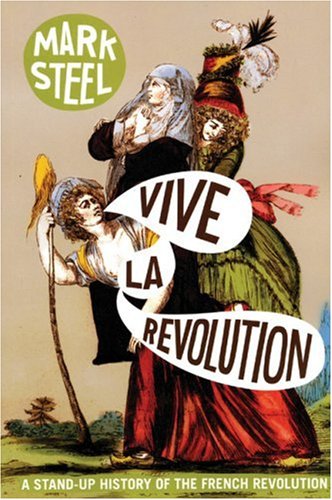All Nonfiction
- Bullying
- Books
- Academic
- Author Interviews
- Celebrity interviews
- College Articles
- College Essays
- Educator of the Year
- Heroes
- Interviews
- Memoir
- Personal Experience
- Sports
- Travel & Culture
All Opinions
- Bullying
- Current Events / Politics
- Discrimination
- Drugs / Alcohol / Smoking
- Entertainment / Celebrities
- Environment
- Love / Relationships
- Movies / Music / TV
- Pop Culture / Trends
- School / College
- Social Issues / Civics
- Spirituality / Religion
- Sports / Hobbies
All Hot Topics
- Bullying
- Community Service
- Environment
- Health
- Letters to the Editor
- Pride & Prejudice
- What Matters
- Back
Summer Guide
- Program Links
- Program Reviews
- Back
College Guide
- College Links
- College Reviews
- College Essays
- College Articles
- Back
Vive La Revolution by Mark Steel
The non-fiction book Vive La Revolution written by the touring stand up comedian Mark Steel, has been described as "A cross between a history of the French Revolution and a spirited defense of the ideals that inspire it" by The Independent. Steel takes into consideration the details of the French Revolution that are not routinely incorporated into most books. Although he may be a talented author Steel has an unfortunate tendency to focus mainly on physical appearance and not on the historic facts of 1789. For example Steel puts a great lot of thought into describing the bulging vein’s in Maximilien Robespierre’s legs, not his term as Estates General.
Mark Steel has created a book telling the story of the French Revolution in an actually interesting, and unapologetic manor. Although he may be a talented author, he has a hapless tendency to focus mainly on physical appearance and not on the many important historical facts witnessed in the momentous year of 1789. The frequent Guardian Newspaper columnist "puts individual people back at the center of the story of the French Revolution", while still maintaining an important educational element of a non-fiction author.
An example of Mark Steel exhibiting an inability to look beyond people’s physical appearance to delve into real history is how he describes the renowned Maximilien Robespierre, a lawyer who once stood for election in the region of Artois (a former province of northern France.) He has been illustrated with characteristics much similar to a frog. “His features were repulsive, his veins a shade of green… something suggested an unspoken terror,” says Madame de Stael the ex-chancellor Necker’s daughter. He is characterised by Steel as “the repulsive green veined, ugly Robespierre.” An account from the historian Nodier say’s “his gaze was an indescribable shaft of light from a wild eye between retractile eyelids.”
A further instance is when Mark Steel introduces Vive La Revolution by discussing Marie Antoinette. "She was specially selected, of noble stock, to marry the heir to the throne, had an illicit affair with an army officer, fell out with the royal family she'd married into, spent unfeasible amounts on clothes and jewelry, became obsessed with charity and lost her life abruptly in her thirties in the middle of Paris." Says Steel, summing up the existence of Marie Antoinette in one paragraph. Vive La Revolution presents Marie Antoinette with her own two pages devoted to her monumental spending habits, “her dress allowance was 150,000 livres, itself 300 times greater than the average annual income.”
The revolution for the most part was controlled by men, in spite of this, women shined in the darkest of times. For example the considerable transformation of society during the French Revolution “led many women to reassess their positions in civilization.” One of the first ever woman to express this was “Olympe de Gouges a butchers daughter, who wrote a document, “the rights of women,” in 1791. She began by stating, with a nod to Rousseau, “Women are born free,”” Not only did she believe this, but she argued for women’s education and suggested the vote for women.
“The ugly Danton” writes Mark Steel, referring to Georges Jacques Danton whose image suggests he “drank, caroused, and debauched his way through the whole event. He became known for having the loudest voice in all of France, and once insisted on wearing his hat through a performance at the theater, leading to such an argument with the manager that the play was cancelled for the night.” Danton as a baby was attacked by a bull and left “severely scarred,” got small pox and was then left with more scars on top of scars. This is what Steel discusses, not how Danton became the first president of the committee of public safety or how his rising restraint and final objection to the “Reign of Terror” led to his unfortunate death at the guillotine.
Mark Steel does a satisfactory job of describing how the French Revolution brought with it the concepts of liberty, equality and democracy to Europe and commenced an extreme and permanent historical reconstruction. He pays attention to details and does not assume that readers will be familiar with history. Steel accesses important facts without creating a monotonous book filled with tedious pieces of information.
In conclusion the non-fiction book Vive La Revolution written by the touring stand up comedian Mark Steel is an entertaining read if you are looking for a more nonchalant example of the French Revolution not in a customary textbook format. Steel exhibits a deficiency to look beyond historical individuals physical appearances to delve into actual history.
Similar Articles
JOIN THE DISCUSSION
This article has 2 comments.
Ummm... I'm not sure you paid attention when reading the book. Mark Steel doesn't remain focused on the physical attributes of the people of the revolution. He does, however, heavily criticise other historians for doing it.
4/10 Try harder next time.

